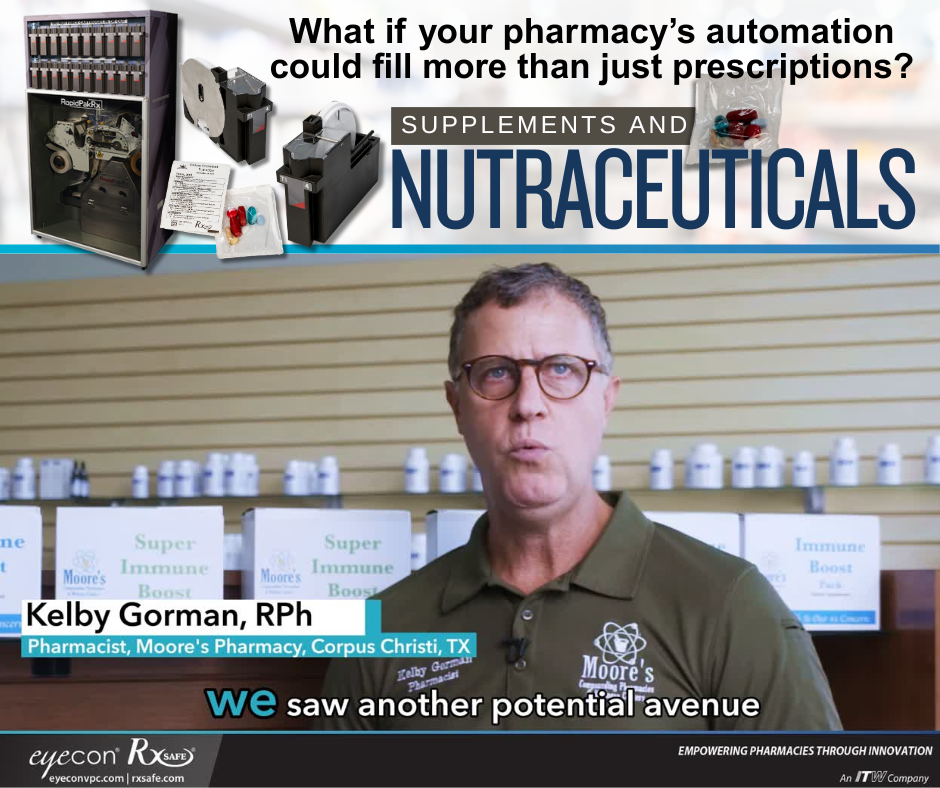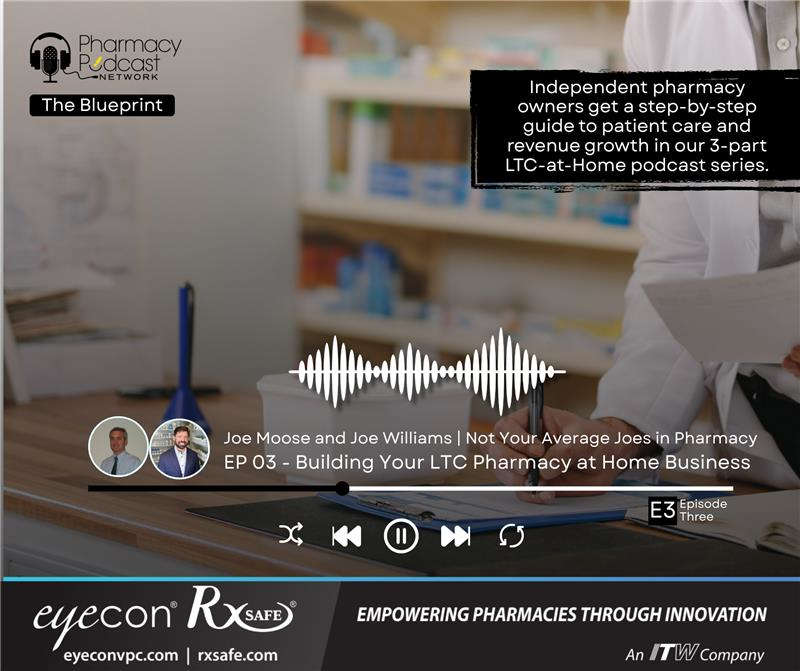What will the year 2019 be like for independent pharmacies? Will reimbursements continue their downward slide? Will Amazon/PillPack increase market share at retail pharmacy’s expense? We asked several RxSafe customers to weigh in on trends, challenges and opportunities they see on the horizon.
Our Panelists:
-
Brian Garner, pharmacist & owner, Hendricks Pharmacy, Claremont, California
-
Vance Kiser, pharmacist & owner, Piedmont Pharmacy, Danville, Virginia
-
Benjamin McNabb, pharmacist & owner, Love Oak Pharmacy, Eastland, Texas
-
Mark Mula, pharmacist & owner, Mula Family Pharmacy, Abbeville, Louisiana
-
Steve Pryor, pharmacist & owner, Scheffe Prescription Shop, Enid, Oklahoma
The Reimbursement Challenge: PBMs, DIRs, Etc.
Garner: I’d say the biggest challenge is the same challenge that’s always been around: problems regarding reimbursement: it just keeps getting lower. This year is no different than last year. It went down again.
Mula: A huge problem is DIR (direct/indirect remuneration) fees. Insurance companies are the only industry that will reimburse somebody at the point of sale, and then come back six months later and say, "Oh, by the way, you owe me half your profits." I can't think of any other, and it's very, very difficult to budget personnel, who you're going to hire. You don't know what your reimbursement is because you sell it and you think you make “x-amount” of dollars and then six months later they come back and they take it away from you.
Kiser: I think the biggest challenge is the masking behind PBM (pharmacy benefits manager) reimbursement. Pharmacies are dealing with clawbacks, DIR fees, MAC (maximum allowable cost) pricing, GER (generic effective rate). All these issues are things that allow the PBM to make money against the spread of pharmacy reimbursement, disguising their actual low reimbursement and making it impossible for the pharmacy owner to tell his actual profit at the point of sale. What looks to be profitable at first could be taken back by the PBM for any number of reasons. Many pharmacy owners are trying to push this in front of their local government, but it doesn't seem they fully understand the depth of this issue.

Pryor: Our biggest challenge continues to be dealing with financial issues that PBMs have created, recognizing those issues and finding ways to deal with them, without just cutting staff. Reimbursement keeps getting lower. We’ve been working with PDS to improve our financial stability and learn how to manage those things. It’s gotten so bad that a lot of pharmacists see negative margins on their scripts. That’s going to be a challenge for the foreseeable future.
Mula: There are times that we have dispensed a drug that's not cheap at all, such as a specialty medication, and we make a little profit; and it's not a ton, maybe a 5% profit. The PBM comes back and they take money, and we actually come out in the red. We've lost money. So, instead of making $50, we turn around and they take $150 from us. They don't just take your profit, they arbitrarily take what they want. That's the biggest issue by far.
Fighting for Profitability
Garner: To improve profitability, all you can really do is increase volume. Cutting costs is difficult. You can only cut costs so much. In fact, costs are going up just as fast as reimbursements are going down. Labor for sure. For me in California, with all the minimum wage hikes, that’s huge. The majority of our staff are impacted. There’s not a lot you can do about that. The answer is, you’ve got to get out there and market. Marketing is essential to increase the business. One trend I see is mobile marketing, social media and geo-fencing. Of course the question is: if everybody’s doing that, then how do you stand out?
Pryor: We are looking at opportunities in other services such as weight management or smoking cessation, other clinical services. It’s hard to get them off the ground and running smoothly. People don’t want to pay out of pocket for those. We also do strip packaging to bring us more customers from the community who need that service. We keep offering different services to stay ahead of competitors. I think you need technology and training to get keep ahead of the curve. Honestly, we haven’t promoted strip packaging enough. But we are trying ads with geo-fence marketing, and we had a film crew here last week to shoot a cable TV commercial. One of the scenes shows a pharmacist raking pill bottles off the counter. People see that and they’re impressed. Customers have told us, “Wow, that’s pretty amazing that you are doing that!”
Mula: With reimbursement, everything is based on your CMS star ratings; so working to increase those ratings, I feel is the only thing we can do. The higher your star ratings are, the higher your reimbursement is. Now, it's not a lot by any means. It doesn't offset the DIR fees, but we have found that that's the only way to combat it because we can't control what they take back from us. We can only control what we do here. We've only been open 3.5 years, and for the last 2 years, we finished 98th percentile in the country in Medication Therapy Management.
Kiser: We take every opportunity to make it personal with each patient. Can we deliver to somebody who lacks transportation, or take an extra 15 minutes to reinforce with somebody the proper way to check their blood sugar with their new machine? Maybe we reach out to mom who had a sick child the day before and got an antibiotic just to check on her and the baby and make sure they are comfortable with their regimen, or comfortable with dosing OTC Tylenol for the child. We do our best to recommend quality vitamin lines, or probiotics, and try to listen to our patients and their needs. I've even had pharmacists visit in-house with patients who were just confused on their drug regimen. With the big box stores buying up and consolidating pharmacies on a daily basis you have to find that way to make it personal with your customer base; it keeps them coming back and recommending you to friends and family. It allows you to promote your product and explain the advantages of what you have to offer and why you stand behind those products. Gain the trust of the patient and offer them something the other guy doesn't, offer them time and an open ear. It will pay for itself down the line every time.
McNabb: From day one, I was really growth minded. The pharmacy I purchased was extremely healthy and well established, but I knew it had become complacent. I decided I had to prepare for the future and prepare for value-based payment models. I remembered seeing stories about a disruptive company called PillPack. It wasn't nearly as well known even just three to five years ago, and I remember how revolutionary that service was, how it helped patients, and how it could potentially attract new customers. I could no longer rely on customer service to be our only major attraction. The big chains have worked hard to improve their customer service satisfaction levels to take away our historic advantage. I started asking myself, what's differentiating me from my competition? How can I attract new patients? I determined adherence packaging would help accomplish all of my goals and would be the major differentiator to drive our future growth.
Will 2019 be the year of Amazon/PillPack?
Mula: Yeah, I've been monitoring the Amazon takeover of PillPack. I've lost two patients to PillPack. Actually, I initially lost three patients to it, but one of them came right back to me. Here's the thing. We're going to be doing this, and we're going to get a similar machine to what they have. There's nothing special in PillPack’s machine. But, the problem with Amazon is it's not local. Everything comes through the mail, and if there's any issue at all the patient is left hanging. The first patient that transferred out to PillPack who transferred right back, she loved us, but she liked the idea of the pouches in the box. She transferred right back to us because they made some kind of mistake as far as not getting with the doctor or there was an issue she had with them. She came right back to me.
Garner: Really the fear is, can Amazon find a way to really make mail order efficient? Right now there are a lot of issues with mail order, that people don’t like. Mail order isn't a new concept. It’s been around for decades. The question here is can Amazon make mail-order work so well that they can get more customers from the retail side? Otherwise, it’s just the same old service companies have been doing for years. PillPack has been trying, but they don’t have the name recognition and marketing budget that Amazon has. For me, this is fantastic news. I can piggyback on all the advertising and marketing of PillPack. Customers will ask me about it, and I’ll say, ‘yeah, we can do that.’ And if you ever have a problem, you can just come in.” For me, it’s great, they can spend all the money on advertising and awareness. One of my big pushes this year is to get adherence packaging going. I’m going to put some advertising out there, now that people are starting to understand the concept. I can say, “We do that, and we’re local.”
McNabb: First of all, patients hate change. They're going to do everything they can to stay with the same pharmacy they've been with for years, right? They've developed this really strong routine and relationship with their pharmacist. This is especially the case with patients who have multiple chronic diseases and take very complex drug regimens. These are extremely hard patients to convert to your business. We have discovered that adherence packaging is the most compelling story and service available to attract the most valuable patients to our pharmacy. Also, It's important to note, adherence packaging isn't just for the patient, many times it's to help the patient's overwhelmed caregiver. I think eventually, more and more pharmacies and chains, not just PillPack, will be doing it. Independents have a great opportunity to excel in this space. We are able to provide a much higher level of service than PillPack mail-order at the local level. Local advantage: the sheer complexity of adherence packaging logistics, we have highly trained home delivery personnel with direct physical access to the patient, and superior care coordination with the local healthcare team. PillPack advantage: they have an outstanding national branding and marketing department.
McNabb: And I'll tell you right now, when we tried calling PillPack to get a transfer from them the other day, the phone rang for 15 minutes before finally going to voicemail, and no one ever called back. This was the main customer service line! I think they're going through a lot of growing pains and will always have those mail-order call-center-type customer service issues. It will be extremely hard for them to compete with the face-to-face relationships our local pharmacy team provides. Adherence packaging mail-order is difficult and requires an extreme level of diligence and coordination to achieve a satisfactory and consistent level of service. It takes a tremendous amount of logistics. Don't get me wrong, PillPack's been doing a good job overall, but working on the local level is very different. The patient-pharmacist-physician relationship matters. When urgent medications changes happen, or when a patient undergoes a transition-of-care event, or the patient has cognitive or communication difficulties, we get the job done. We have the competitive advantage. We currently provide a level of service far beyond the abilities of PillPack. Maybe in the future Amazon/PillPack opens brick-and-mortars in every zip code, maybe they employ a network of community health workers? Until then, I'm not concerned.
Predictions, “Curveballs” and Opportunities
Kiser: In 7 years of owning a drugstore, I believe this industry is basically trying to hit a curveball or a nasty knuckleball even. Every year, somebody is trying their best to thin your margin, or squeeze you a little tighter any way they can. The curveball I would like to see, would be the independent industry stepping up and throwing a curveball back by forming a coalition to combat the unfair practices we face every day. We need to put the value back in pharmacy. The risk is all at the retail level where we are under constant pressure to do it faster, do it without mistakes, and do it for less. We need to put the value back into our business and stop letting the PBMs fill the false narrative that they are there to save the public money from the big bad pharmacy. Last I checked, the PBMs make up quite a bit of the Forbes list with some topheavy presence. Health care costs are rising at rapid rates, and it won't be long before we as a whole say, “No more.” We prepare by being ready every day for what that day may offer. I always say, if you aren't moving forward then you are standing still, and if you are standing still you are falling behind. You have to leverage technology, resources, and common sense to better your business every day. Then when the curveball comes, you've prepared yourself to take the swing.
Pryor: Be ready for anything. Sometimes problems or curveballs are actually opportunities. The first thing you have to identify: is it a threat? We don’t have a lot of unexpected things happen but you never know what could come along. In this industry you have to adapt. Trump is talking about getting rid of rebates. What if drug manufacturers got rid of rebates on their own? What if they told PMBs, “We won’t do it. We’ll just lower price of our medications by 50%.” If enough drugmakers did that independently, there wouldn’t be anything left for the middlemen. The PBMs wouldn’t have a plan, because it’s a level playing field. It will be interesting to see what happens. Meanwhile, we keep doing what we’re doing and look at individual opportunities and find win-win solutions for us and our patients. That’s our goal really. Anybody can fill prescriptions, or even do mail order. We provide a different level of service than they do. Our customers appreciate it.
Garner: I wouldn’t be surprised if Amazon ends up buying a PBM this year. Now they’re picking up the middleman. That’s how CVS Health does it: they own the pharmacy, the health plan and the PBM. They can discount things all over the place and there’s nothing you can do about it. Legislation to rein in the PBMs or to change DIR would help. But the perception is that PBMs generate a lot of savings for Medicare.
McNabb: I think it's interesting to start considering ... and I'm sure Amazon and PillPack consider it this way ... adherence packaging is a lot like any online subscription-based service. I'm especially interested in the business strategies, marketing techniques, and industry benchmarks of major online subscription-based services. What should my average online customer acquisition cost be? What is the average lifetime-value of a customer? How can we maximize the profit opportunity of each "subscriber"? Should our business charge an “Amazon Prime”-like membership fee? Mastering these concepts could become very important to maximize our growth potential and profitability. It's been fun thinking about things a little differently.
Mula: My biggest fear is not the corporation. I can compete all day long with the corporate offices, that's the easy part. The hard part is the reimbursement and the DIR fees; it's something I cannot control. The other stuff I can control. The end of the last three months of 2018, we grew rapidly. It was our third year in business and our growth was really just acquiring customers from chain stores. I keep a sign at my register that says, "We love chain store pharmacies. We get all of their patients." I'm serious. People laugh, and then they transfer their scripts to us. So far, in 2019, I looked at the numbers at mid-month, reimbursements are down, but our numbers are higher. We're looking for another good year. Hopefully, in 2020, then we start getting ahold of this DIR fee situation.
Editor’s Note: Just before this blog was published, a years-long effort led by the National Community Pharmacists Association to build support for a proposal to move pharmacy price concessions to point-of-sale reached a major milestone. On Jan. 25, nearly 3,500 pharmacists and 170 patients formally voiced their support for parts of a proposed Centers for Medicare and Medicaid Services (CMS) drug pricing rule that would eliminate the retroactive nature of pharmacy DIR fees. The proposed rule, which is titled “Modernizing Part D and Medicare Advantage to Lower Drug Prices and Reduce Out-of-Pocket Expenses,” will go through one more round of edits and is slated to be finalized by CMS in April.
Interested in growing your business and inoculating your pharmacy against future market changes? Be sure to consider the RapidPakRx strip packaging system. When you purchase a RapidPakRx, we include -- at no charge -- RxSafe’s medication adherence marketing services, known as PakMyMeds™. This program catapults your marketing efforts with packaging, digital marketing and printed collateral to make adding an adherence program to your pharmacy’s offerings as simple as possible. Call us at (877) 672-4956 to learn more today.


.png)
.png)



.png)


